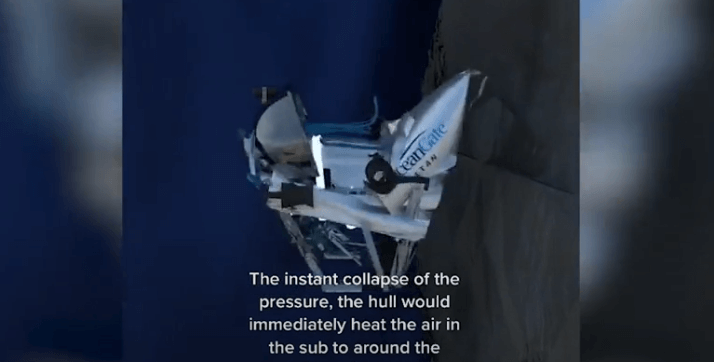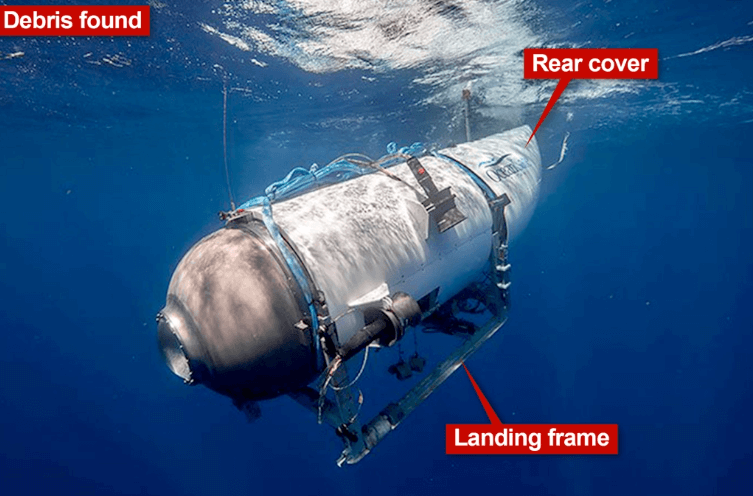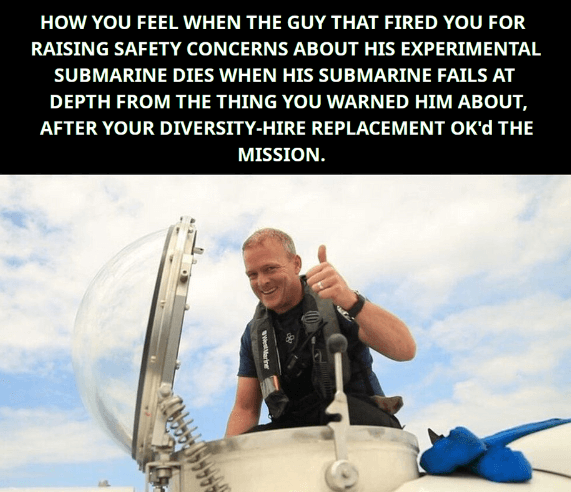On Thursday, the US Coast Guard announced that an implosion killed all passengers instantly as they plummeted to the sea’s black depths to explore the 111-year-old remains of the Titanic.
Debris from the Titan wreckage found on the ocean floor — some 12,500 feet below the surface — is “consistent with the catastrophic loss of the pressure chamber,” which means the weight of the ocean crushed it sometime after the Titan lost touch with its surface vessel Sunday.
So the thing we all knew happened has now been confirmed.

Aaron Amick, the retired US Navy sonar operator who we referenced in the first piece, didn’t have any doubt that the sub had some catastrophic failure. However, there was a lot of nonsense about the Canadian military hearing a banging noise from that area. I felt that could be safely ignored, since the description was so vague as to be pretty much anything, and there was no regularity to the banging.
Mr Cameron said the search “felt like a prolonged and nightmarish charade where people are running around talking about banging noises and talking about oxygen and all this other stuff”.
Speaking to BBC News, he added: “I knew that sub was sitting exactly underneath its last known depth and position. That’s exactly where they found it.”

James Cameron is a huge asshole, but even he is speaking rationally here. The only reason why anyone pretended that these billionaires were still alive, is because they were billionaires, and our (((Democracy Class))) likes the anti-White CEO. There was no rational reason to believe they survived. Cameron actually gives a more detailed breakdown of what he thinks went wrong.
But I think the weakest link, if I had to put money down on what the finding will be, the Achilles heel of the sub was the composite cylinder that was the main hull that people were inside. There were two titanium end caps on each end. They are relatively intact on the sea floor, but that carbon fiber composite cylinder is now just in very small pieces and it’s all rammed into one of the hemispheres.
So it’s pretty clear that that’s what failed. The question is, was it the primary failure, or a secondary failure from something else happening. But I’m putting my money on the composite because you don’t use composites for vessels that are seeing external pressure. They’re great for internal pressure vessels like scuba tanks, for example, but they’re terrible for external pressure.
So this was trying to apply aviation thinking to a deep submergence engineering problem. And uh, we all said it was a flawed idea, and they didn’t go through certification so it wasn’t peer-reviewed by other engineering entitites.
Trying to apply aviation thinking? Hold on a second. Jaime, can you pull up that quote of Stockton Rush from the last piece, please?
Because we’re doing things that are entirely new. We’re using approaches that are largely in the aerospace industry as related to safety and uh, some of the preponderance of checklists and things we do for risk assessments and things like that that are more aviation related than ocean related.
It’s almost like aviation and deep sea exploration are different fields. But let’s just totally ignore that for some reason. What’s the worst that could happen?

AN explorer who braved plunging to the Titanic wreckage on the same submersible that has vanished branded the dive a “suicide mission”.
Arthur Loibl, 60, embarked on the daring voyage in 2021 with Titanic expert Paul-Henri Nargeolet and OceanGate CEO Stockton Rush – who are both trapped on the missing vessel.
He paid out almost £90,000 for the trip – but before the sub even started its descent the team ran into issues.
Mr Loibl said the first sub “didn’t work” before their vessel eventually went into the water five hours later than scheduled due to electrical problems.
But just before it was set to launch, he told how the bracket of the stabilisation tube – designed to balance the sub – tore and it was reattached with zip ties.
Mr Loibl said they were forced to sit cross-legged on the cramped sub for ten hours.
Guests and journalists who risked their lives to make the trip told of radio failures, flickering lights and being at the mercy of deep sea currents.
One Brit who signed up for a dive in the missing Titanic sub pulled out — questioning if the firm running it was “cutting too many corners”.
But he found its controls were “based on computer game-style controllers”.
Chris dropped out after becoming concerned by the quality of technology and materials used by OceanGate Expeditions.
OceanGate Expeditions. The comfort of a torture device. The safety of a real military sub in the middle of a warzone. But in exchange you get a view that is… no different than what you would have gotten had you just watched a film of a remote controlled submersible with a video camera.

You should sign up for their next trip. They’ve been a crushing success thus far.


















What an absolute fucking horror show. Imagine paying 250k USD to sit in a cramped humid stinky uncomfortable coffin as you are slowly lowered to the depth that the you will be crushed and incinerated into dust by a 400 atmosphere implosion. I bet it was creaking and making scary concerning sounds as the pressure increased until suddenly they all died in 25 milliseconds.
An anti-white boomer piece of shit, two pajetts, a billionaire with dubious origins so no loss there. The Frenchie seems to have been a decent guy, for a boomer, so RIP to him.
Yeah, the French guy seems like the only real loss here.
Shame that the French guy (Paul-Henri Nargeolet) visited the Titanic 37 times with no issue, it was his first in this supposed “sus” new submersible “Titan”.
As an added piece of trivia, Rush had a jewess for a wife: https://www.jns.org/world-news/topic/23/6/22/297381/
May help explain some of his attitudes towards old White males.
When somebody who does underwater shit for a hobby is saying your engineering approach is retarded, then the outcome we’ve observed is hardly surprising. Aviation and deep sea exploration aren’t just different disciplines, they’re literally polar opposites – that being said, the pressure differences between the inside and the outside of an aircraft (even at extremely high altitudes) is a small fraction of what a submarine experiences.
If anything, it’s a miracle that Oceangate was able to stay in business for as long as it did.
Seems like the only aviation thing that OceanGate didn’t want to incorporate was safety checklists and procedures, and redundant systems.